Installation of CCTV cameras: types of cameras, selection + installation and connection do-it-yourself
CCTV systems are firmly entrenched in our everyday life. Now it’s hard to imagine not only a large enterprise, but also a small shop, office without them. By arranging a video surveillance system, we protect our homes from unwanted visits.
Thinking about purchasing such equipment, you have to deal with a lot of questions. Which video system is better, what its characteristics indicate, how to choose a suitable model, is it possible to independently install video surveillance cameras and connect them? All of this will help to understand our detailed review.
The content of the article:
Types of CCTV cameras
There are various types of cameras in this market segment. They differ from each other by the principle of work, design, technical characteristics.
According to the principle of action, two large groups of devices are distinguished:
- analogue
- digital.
Visually, they are difficult to distinguish, but if you know some of the nuances, then you will never confuse them.
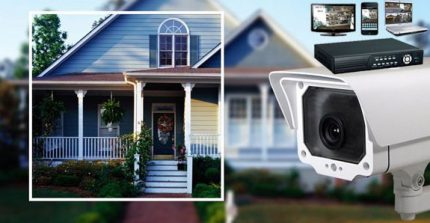
Based on the design features and installation location, the most popular are the following types:
- Classic or cabinet. Install them mainly from the outside, provided that they are equipped with a thermal casing.
- Dome. Most often installed on the ceiling indoors, but can also be used for outdoor installation.
- Swivel. Such a device, the user behind the remote control can expand, enlarge the image. The system is convenient when you need to instantly respond to a situation.
- Panoramic. Provide maximum visibility, minimizing the presence of “dead” zones. If necessary, the picture can be divided into separate fragments.
- Mini cameras. Indispensable for the need for covert surveillance.
Street cameras (street - street) are present at both large and small objects. Important characteristics for them are remoteness from the object, viewing geometry, image resolution.
Typically, these models are equipped with IR illumination, a housing that protects against external influences. It is important that there is the ability to configure individual parameters automatically.
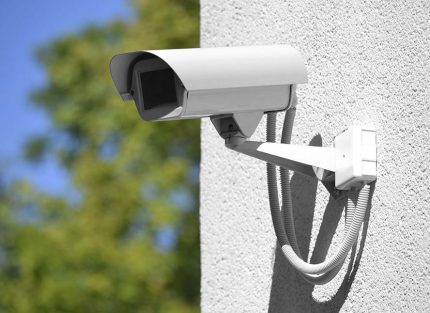
Dome cameras installed in offices, shopping centers, educational and medical institutions, in stores. The device is a semicircular sphere of small size.
The device has a viewing angle ranging from 60 to 100⁰. They are black and white and color, with and without highlighting. They are compact, have a weak response to interference, and can be shot both in the daytime and at night.
Dome PTZ cameras used to protect large areas. Their rotation occurs through the ptz mechanism. You can even operate the camera remotely. The picture can not only be rotated, but also scaled.
Installation of such a camera is acceptable in the room. The high level of security of this equipment allows its use in difficult weather conditions, in the nuclear and chemical industries.
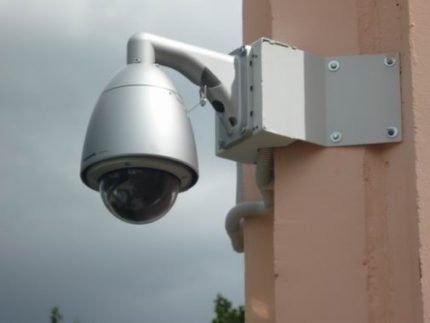
Box cameras. Their popularity is small - they are not very convenient due to the fact that you need to independently assemble them with a lens and a bracket.
Basically, they are mounted on the outside, and if inside, then only in such specific places as, for example, a bank cash desk. Such a camera produces a high-quality image, the signal transmission range is quite large, the lens can be changed depending on the distance to the object.
Mini cameras can be powered by a battery; there are both wired and wireless models. They are recorded on a mobile device via a GSM module or on a memory card. They have a high protection class and good technical characteristics.
No. 1 - digital cameras and their characteristics
A digital or IP camera captures the signal in digital form and in the same form transmits it to the consumer through a computer network.
Externally, such a camera differs from the rest only in the connector. If in analog devices this is a BNC - coaxial RF connector, then the IP camera is equipped with a twisted pair connector - RJ-45.
Such a CCTV camera is connected to a computer, but here it should be noted that it is not worth building an entire surveillance system based on a home computer.
It is not designed for continuous 24/7 operation and will fail very quickly, especially if several cameras are included in the system. For a hard drive, this can be too much of a load.
It is better to purchase a DVR right away, although many IP cameras are a standalone device and have an individual web interface.
There are cameras with a connector for a USB flash drive or with an SD card slot where you can archive recordings. In this case, the need for a DVR disappears.
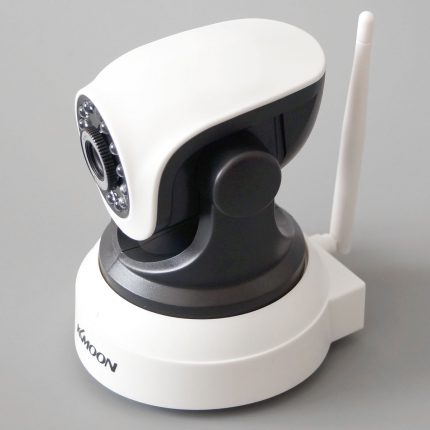
A great advantage of digital video cameras is that at least at the other end of the world, you can watch what is happening in your office or at home through a laptop monitor or mobile smartphone.
IP-based cameras differ from each other in housing design.
IP cameras can be connected to cloud storage, with their participation, you can create a large-scale video surveillance system and include a large number of devices in it.
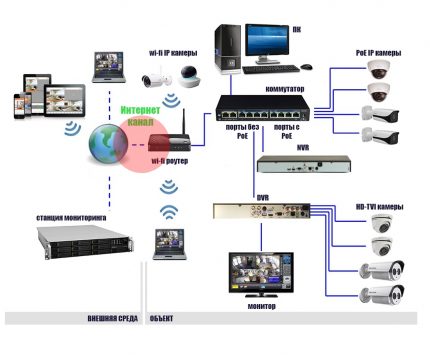
Thanks to an invulnerable authorization system and reliable data encoding, a high degree of security for users is guaranteed.
Also, these devices have great integration potential. You can remotely control video surveillance, lighting, and a fire system from one device.
Digital IP video recording has a high resolution, which allows you to see small details, clothes, a person’s face without blurring.
Analog cameras do not give such a clear picture, it is difficult to identify what is seen from it. This is explained by the fact that an analog video signal is generated using a TVL alternating system.
In digital-type cameras, the alternation of lines by using the technology of sequential scanning is removed. Clearly captures the IP camera and fast-moving objects.
No. 2 - features of analog cameras
An analog camera can be easily recognized by looking at the description. If there are three English letters NVL - this is an analog camera.
This format is the simplest - there is a camera in the circuit, and two conductors are connected to it. One of them receives power, the other - a signal is taken. The output image is not of very good quality.

The resolution limit of analog cameras for video surveillance is 720 x 576 pixels, which is several times lower than in modern digital cameras.
Such cameras are called capable of transmitting an image only over a short distance, simply analog or CVBS. Such outdated standards include VGA, D1, 960H devices.
No. 3 - New Standards or HD Cameras
According to the same principle that a simple analog camera has an HD camera, only this is a more advanced view in which three main formats are connected together: TVI, AHD, CVI. This is a breakthrough in analog video surveillance.
They can transmit an image with a resolution of:
- 0.4 MP - 722 * 576;
- 1 MP - 1280 * 720;
- 2 MP - 1920 * 1080;
- 3 MP - 2048 * 1536;
- 5 MP - 2560 * 1920.
Their quality is comparable to IP cameras. The latest equipment is capable of transmitting the maximum clarity of the image captured on the subject.
The image acquisition mechanism can be briefly described as follows:
- After passing through the lens, the image focuses on the CCD.
- Light energy is converted into an electric charge.
- The electric charges are converted into an analog type signal.
- The signal is transmitted via cable to the receiver.
There is no conversion of the electrical signal into binary code, it comes to the recording device unchanged. This distinguishes analog cameras from digital.
This monitoring process greatly simplifies the need for processing on a computer.
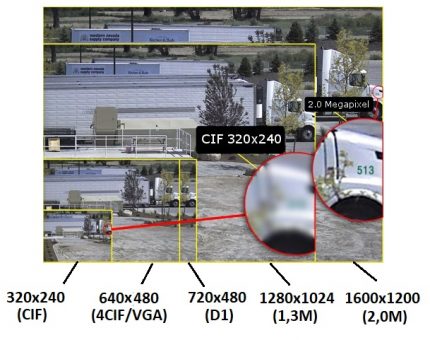
If you connect an analog video camera with a digital converter, you will be able to receive a signal from several cameras.
When purchasing any camera from the AHD, HD-CVI, HD-TVI category, you should know that they are all incompatible with each other, since they are produced by different companies. When buying a camera of a certain standard, you need to select a DVR that supports the same standard.
HD-SDI devices are standardized, so they are compatible with all DVRs. IP cameras are standardized by ON VIF.
This organization is engaged in standardization of equipment and IP cameras including.They also develop specifications for them. Camcorders of the same specification are compatible.
Rules for choosing a surveillance camera
Given the abundance of offers on the market, it is difficult to decide which camera to choose. First of all, you need to determine the standard by evaluating a number of parameters.
Functionality. If you need a high-quality picture, the presence of intelligent options is important - motion detection, presence detection, high detail then you need to acquire an IP camera.
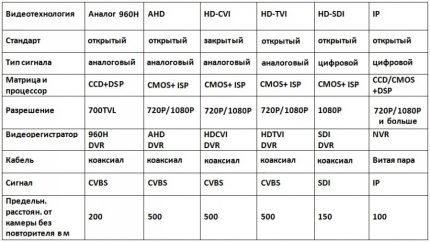
Another nuance: although there are cameras that work autonomously, you cannot include a large number of them in the system - optimally no more than four pieces. Otherwise, it is better to use the option with a DVR.
Resolution. With the transition of analog cameras to the HD format, this parameter approached the characteristics of IP cameras. This standard is applicable on any objects, but nevertheless small details can not be considered.
In favor of their choice, the price inclines, but their functionality is lower and they need a video recorder.
Place of installation. If you need to install a video surveillance system from the outside, then the cameras must have the appropriate characteristics. Dome cameras are well suited for indoor installation without additional protection.
Lens viewing angle and focal length. A wide-angle short-focus lens is a good solution for a cottage, office.
A telephoto lens and a maximum 45-degree viewing angle are a good option for entering a house or for controlling a distant object when clear detail is a priority.
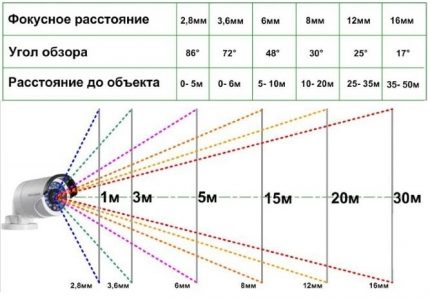
There are cameras equipped with a lens having a certain focal range, ranging from 2.8 - 12 mm. Such devices are called “varifocal”.
Based on your needs, you can adjust the viewing angle yourself. The cost of such cameras is much higher than devices equipped with a lens with a stable focal length.
Some consumers, when buying a camera, are guided by the number of megapixels. This is not entirely true. It is often difficult to see the big difference in image quality from an IP camera with 2 and 8 MP. But the cost is significantly different.
Photosensitivity. This parameter is of great importance when choosing a camera for round-the-clock surveillance. This is the minimum light threshold at which the camera can function.
The higher this parameter, the clearer the picture obtained at dusk and at night. The latest models almost all have IR illumination, so video surveillance is effective even when it is completely dark.
Given these circumstances, you must definitely look at what lighting conditions the camera is designed for. Before that, you need to measure this parameter with a light meter in the place where the camera is supposed to be mounted. If in the future the device will work around the clock, the photosensitivity should be at least 0.01 lux.
Since illumination during the day cannot be stable, you need to make sure that the camera’s design includes automatic adjustment of the aperture. Such devices are capable of maintaining a stable luminous flux incident on the matrix.
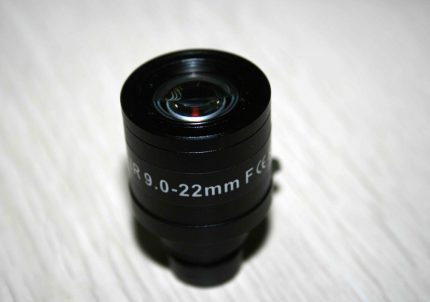
WDR cameras are better. Even many economy-class cameras support this feature, which allows you to display an image without deep shadows and too bright areas.
The only difference is that expensive cameras are equipped with genuine WDR, and budget cameras are equipped with "analogues."
If video surveillance should not stop either day or night, and the information from the camera should be as detailed as possible, we need a model with a day-night mode. As soon as night falls, it goes into monochrome mode automatically. The IR filter cannot provide a color picture.
Backlight. A camera that will work at night must have infrared illumination. The key parameter of IR illumination is the range. 10 to 20 m is enough for a room, more than 20 m on the street.
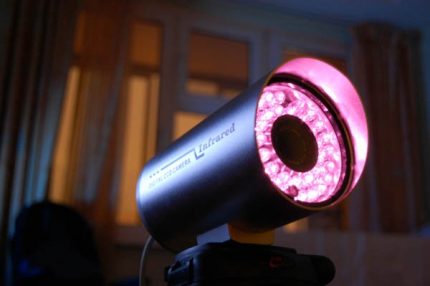
The latest camera models are equipped with adaptive backlight. Its role is to adjust the power depending on the location of objects located near the camera.
Self-assembly system
Going to increase the security of your home by video surveillance installations, you can choose two ways to implement this idea: apply to specialists or do the installation of CCTV cameras yourself.
The first method is quite expensive, and the second is quite feasible if you are familiar with modern technology, and a drill is a familiar tool for you.
Stage # 1 - planning and video surveillance schemes
From the very beginning, it is necessary to determine the installation location, the number of cameras and their task. If you have a private house or a summer residence, then observation should cover not only the internal premises, but also the local area.
In an apartment, cameras are most often installed to control the situation during the absence of the owners. It is advisable to have them in living rooms, especially in places where some valuables are stored. It is worth thinking about installing a camera at the entrance to the apartment.
Having decided on general questions, they begin to develop a scheme. Places of the proposed wiring are chosen so that they do not intersect with the existing power line.
It can become a hindrance to the video signal if the distance to it is less than one meter. It will protect against interference and protection in the form of a metal sleeve, wires are put into it and ground.
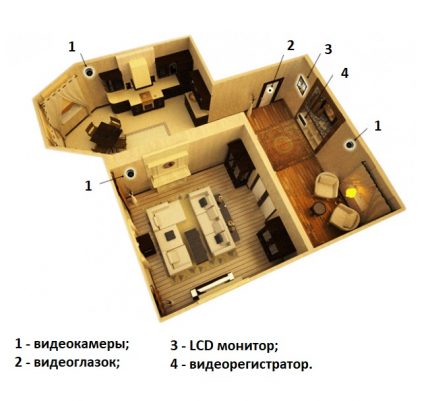
The next step is to determine the viewing angle. Depending on the objectives, it can be adjusted so that small details are visible or to increase the capture, while sacrificing details.
Next, you should consider where to place the DVR and monitor. Given confidentiality, access to them should be limited. Well, if there is a separate enclosed space or at least a closet.
Stage # 2 - system installation
Start by installing the actual camcorders. Inside they are placed under the ceiling. The main thing is that they are close to outlets. Outside, video surveillance devices are positioned so that it is impossible to disrupt.
Mounting the camera consists of several operations:
- dismantle the mounting casing;
- apply it to a pre-selected location and make markings through the mounting holes;
- take a punch and drill a wall or ceiling, after which dowels are inserted;
- apply a casing, combining the mounting holes on it with drilled on an attached plane;
- screw the screws and complement the body with a lens;
- set the viewing angle of the device.
Experts do not recommend installing video surveillance devices too high. A clear image can be obtained if the camera is not more than 4 m from the ground. In order not to light up the picture, you cannot position the camera opposite the sun.
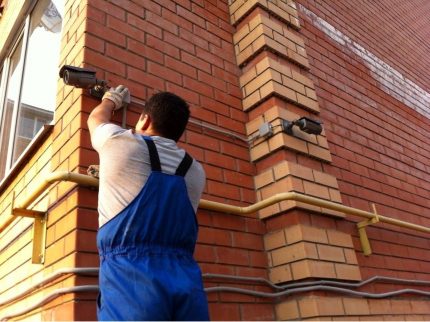
In addition to fastening with screws, there are other options: suction cups, Velcro. The first way to mount video devices is still considered the most reliable.
Stage # 3 - connect the camcorder correctly
There are only two types of connection: to a power source and to a device that receives information.
To nutrition. Since there is an adapter in each camera through which a reduced voltage is supplied, its plug is simply plugged into an outlet. The plug at the other end is inserted into the camera. To do this, there is a special socket on the back of the camera housing.
To the receiving device. For the second connection option, it is necessary that there is a wire equipped with BNC -RG6 connectors. On the video device, it has an output (output), and input (input) on the receiver.
Connecting a wireless camera is even easier. A program disc is usually included with the camera. It remains only to install it on a computer.
Next, connect the router via wi-fi, then the camera itself. It is connected to the network and using network cableconnect to the router.
The next step is to configure the network settings in the program itself. To do this, enter the key and other data and disconnect the network cable. After a reboot, the camera will independently connect to the router. Now the picture transmitted by the camera will become available.
Video cameras can be an element of the intelligent system “smart home”, which manages various equipment in the room. Read more about the device and the capabilities of such a complex in this article.
Conclusions and useful video on the topic
To make it easier for you to understand the intricacies of installing equipment and connecting it, we suggest watching the following video, where these issues are covered in detail:
The main condition for the correct choice of a video camera is its compliance with the conditions where it will be applied. Even if the selected equipment is far from expensive, and it will take a lot of effort to install it, the security of your home is worth it.
If you have doubts about your own strengths, then the best option would be to contact an organization / company specializing in the installation of video surveillance systems, including cameras and other equipment.
Choosing CCTV cameras for a private home? Or have experience installing and using such equipment? Please leave comments on the article, ask questions and participate in discussions. The contact form is located below.

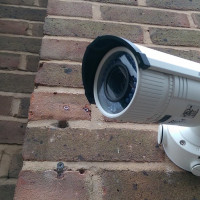 DIY video surveillance for a private house: design + installation rules
DIY video surveillance for a private house: design + installation rules 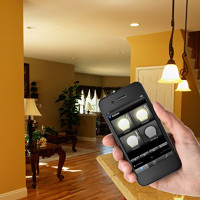 Remote lighting control: types of systems, equipment selection + installation rules
Remote lighting control: types of systems, equipment selection + installation rules  The Smart Home system for a country house: advanced devices for automatic control
The Smart Home system for a country house: advanced devices for automatic control 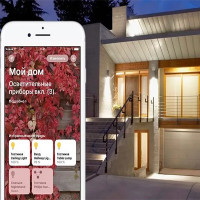 Apple smart home: the intricacies of organizing home control systems from the apple company
Apple smart home: the intricacies of organizing home control systems from the apple company 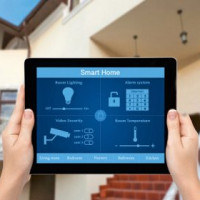 Smart devices for the home: TOP-50 of the best gadgets and technical solutions
Smart devices for the home: TOP-50 of the best gadgets and technical solutions 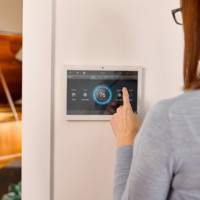 Heating in a smart home: device and principle of operation + tips for organizing a smart system
Heating in a smart home: device and principle of operation + tips for organizing a smart system  How much does it cost to connect gas to a private house: the price of organizing gas supply
How much does it cost to connect gas to a private house: the price of organizing gas supply  The best washing machines with dryer: model rating and customer tips
The best washing machines with dryer: model rating and customer tips  What is the color temperature of light and the nuances of choosing the temperature of the lamps to suit your needs
What is the color temperature of light and the nuances of choosing the temperature of the lamps to suit your needs  Replacement of a geyser in an apartment: replacement paperwork + basic norms and requirements
Replacement of a geyser in an apartment: replacement paperwork + basic norms and requirements
Image quality may be higher. My opinion: the essence is not in the number of megapixels of the device. Many factors affect the clarity of the picture: this is the level of light penetration, matrix type, focus and other circumstances. You see, there are technologies in the production of video matrices, plus another concept such as an increased percentage of pixels, the material of sensors and their quality, the use of microlenses. It is also important how the technological factors work. Therefore, my conclusion: American CMOS-matrix, for example, Aptina AR0330 with 3.5 MPx is much better in percentage of sensitivity, due to which interference is less reflected in broadcast quality than it was in the 5-megapixel model.
We live in a private house, the territory is large. There is no dog. They began to notice that someone climbs in our yard at night. We wondered which video camera to put. Decided that digital. Digital IP video recording has high resolution, you can see small details, clothes, a person’s face. If necessary, you can split the picture into separate fragments.I also like the fact that you can monitor what is happening remotely. As for the fact that you should not focus on the number of megapixels, I do not agree. We checked the image from cameras from 2 megapixels, those with more megapixels transmit the image much more clearly.
I installed analog cameras on my site, I chose a cheap option, so the picture quality can not be said to be excellent, but this is enough.